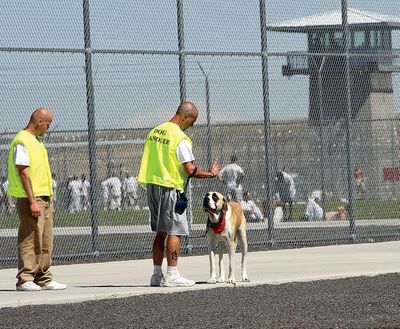Inmates reach out by training dogs
Shelters embrace program that leads to adoptions

CONNELL, Wash. – Convicted murderer Danny Manoi never thought his temper would allow him to share a cell with someone of a different race, let alone a different species.
Manoi, 44, has a violent history. He routinely assaulted other inmates and bucked authority, he said. He’s serving a 46-year sentence for killing an auto repairman in 1995.
“I wasn’t the nicest person,” he admitted outside his cell at Coyote Ridge Corrections Center, a medium-security prison in Connell.
Now, however, there’s a Great Dane named Hannah in his life, part of a program called Ridge Dogs. Inmates train and rehabilitate rescue dogs from Benton, Franklin and Adams counties who are candidates to be euthanized.
Prison staff were hesitant at first about the idea of letting Manoi work with dogs. But they say he’s taken a “complete 360” since joining the program.
Hannah, who sleeps on a mattress in Manoi’s cramped cell, strutted out from her bed to greet a group of visitors recently.
The tall, black dog rubbed up against Manoi as he praised her for her welcoming demeanor. The high-pitched voice he used to show his approval provided a stark contrast to his bulky frame and prison tattoos.
“Very good,” he said, patting the dog on her head. “Very good, Hannah.”
Manoi and 41 other prisoners rigorously train the dogs during a period of two to six months, sometimes longer, depending on the dogs’ needs. Each dog is screened beforehand for overly aggressive behavior.
The dogs are provided by the Benton-Franklin Humane Society in Kennewick, Adams County Pet Rescue in Othello and Forgotten Dogs in Kennewick. The agencies provide the food as well as microchips, vaccinations, spaying and neutering.
The dogs are offered to the public for adoption once the training is complete.
Ridge Dogs has grown immensely since it first was introduced at the prison in October 2010, said Lori Telleria, the prison’s correctional program manager.
It started with six inmates and two dogs, partnered with one animal shelter. Now, more than 40 inmates train about 20 dogs at a time from three shelters.
The ultimate goal is to provide stable new homes for neglected dogs. They receive more than 200 hours of training and go through three levels of instruction before they “graduate,” said inmate Glenn Northrop, the program’s clerk.
The inmates meet with certified trainers once a week and use methods sanctioned by the Association of Pet Dog Trainers and the American Kennel Club.
Each dog is assigned three inmates, who split caring duties. One of the inmates, called a mentor, oversees the training and helps the less-experienced inmates – called handlers – develop the dog’s social skills and behavior.
Elaine Allison, director of the Benton-Franklin Humane Society, said the inmates have impressed her with their knowledge during the training sessions she leads.
With their level of experience, many inmates could work as certified private dog trainers earning around $200 an hour, Allison said.
“The skill level that these guys have is good enough for them to get their Certified Pet Dog Trainer certificate,” she said. “You have to know your stuff to get that certificate.”
More than 70 dogs have been adopted since the program started, Northrop said. Some are adopted by prison staff, and the animal shelters help find homes for the others.
Inside a training room, a pit bull mix with a brown and white coat named Billy Bob sat by an inmate’s feet, eagerly eying another dog’s treats.
Billy Bob’s mentor, inmate Darren McCarroll, 34, glowed with pride as he talked about the dog and the progress he made.
“It’s a real happy feeling,” said McCarroll, who worked with Billy Bob for two months. “I made a difference in a dog’s life. He went from death row to living on the outside.”